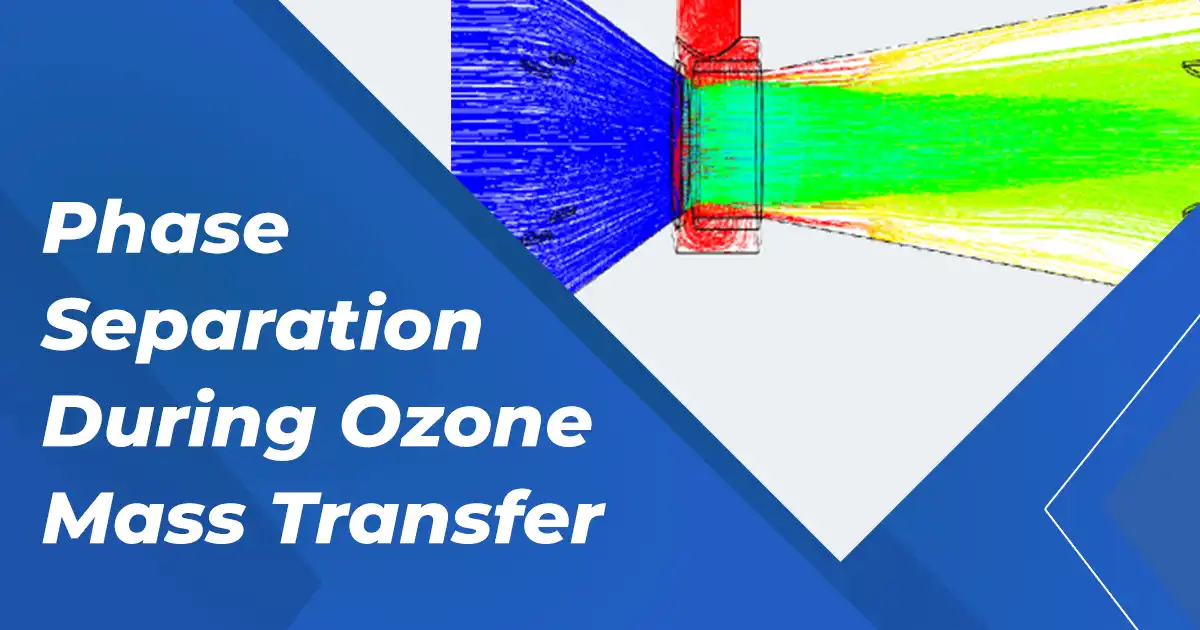Phase Separation During Ozone Mass Transfer

Ozone is a gas. It is an unstable gas. It reconverts to oxygen with time. Hence ozone has to be produces in situ, and dissolved immediately. For ozone to work as a disinfectant in water (and waste water) the ozone has to be dissolved in the water. Like any other substance, ozone’s solubility in water is not unlimited. When solubility limits are reached, ozone does not dissolve any more
The solubility of ozone in water is dependent on many factors. Some of the factors are:
1) ozone concentration
2) temperature of water
3) pressure of gas and water.
4) surface area The Higher the ozone concentration, the more the ozone dissolves.
It follows the Henrys law. The lower the water temperature, the more ozone dissolves. The higher the ozone gas pressure, the water pressure, the more ozone dissolves. The more the surface area, the more ozone dissolves. (Decreasing the bubble sizes will increase the surface area).
Various scientific models are available to make precise calculation to determine how much ozone will dissolve in various conditions during mass transfer. Research in the ozone field on these subjects have resulted in few companies manufacturing ozone equipments that produces ozone at concentrations as high as 15 % and above , and ozone gas pressures even up to 3 Bar.
Whatever concentrations and pressures you use, it is imperative that you have to strive to keep the ozone in solution and prevent phase separation. You have to keep the ozone in solution long enough for it to complete its disinfection. Phase separation can occur during some of the following conditions:
1) when there is an increase in temperature of the water
2) when you do not provide sufficient surface area for dissolution
3) when there is lots of turbulence in the water, and the ozone is stripped from the water.
Designing a good mass transfer system is the essence in any ozone application. Success or failure of process will be determined. Mass transfer systems also determine the cost of ozone application, since power and accessories cost vary with different mass transfer devises. We have to strike a balance to ensure we keep the cost down but at the same time ensure efficiency.
Diffusers and Venturies coupled with mass multiplier nozzles are two of the common mass transfer devices used in many ozone applications
Diffusers are mostly used in large ozone applications where the water quantity is large and it would become too expensive to use venturies and pumps. Diffusers use ceramic/SS differs mounted on manifolds and placed at the bottom of the contact tank. The design of the diffuser system must consider the following to ensure proper ozone mass transfer
1) gas –liquid ratio
2) increasing surface area by reducing the bubble sizes.
3) Preventing channelling of bubbles
4) providing sufficient contact tank height.
5) avoiding turbulence in the tank.
6) directions of water and the ozone gas.
7) Sufficient contact time will then allow completion of ozone actions
Venturies are more common. They are mostly used in smaller applications but can also be used in large ozone applications replacing diffuser system. There are lots of controversies today in the efficacy of diffusers systems with two different schools of thoughts.
Venturies have to be designed well to ensure it sucks more than 99% ozone into the venturi. This will depend on the specifications and performance of the venturi and the design of the injection pump. they have to complement each other. The venturi adopts large surface area principal by forcing the ozone into very small bubbles and forcing it into solution. The high pressure produced by the pump facilitates this further. Using mass multiplies nozzles at the end can increase ozone mass transfer further. Since the venturi works on certain principles, it is advisable to use venturi and other accessories from reputed manufacturers rather than making your own venturi and not knowing how it will perform and to what extent.
These are some of the simpler steps that need to be taken for efficient ozone mass transfer , but it is more complicated than this , especially in very large applications where the quantum of ozone gas is very small when compared to the volume of water. This is a big challenge


